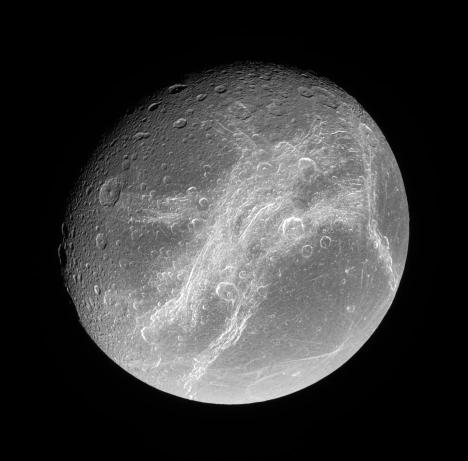Scientists have received the latest clues to aid their hunt for water in outer space with photographs taken by the Cassini spacecraft. Images of Saturn’s moon, Dione, focus on the 500-mile-long mountain Janiculum Dorsa—a landmark scientists use to compare Dione to Saturn’s geyser moon, Enceladus. Using Janiculum Dorsa along with other findings, researchers speculate that Dione may have once had a geologically active subsurface ocean.
 Discovering subsurface oceans on Saturn’s moons Enceladus and Titan, Jupiter’s moon Europa, and now potentially Dione have led scientists to believe that there may be more worlds with water than previously imagined. These moons have played a crucial part in advancing the search for life beyond Earth.
Discovering subsurface oceans on Saturn’s moons Enceladus and Titan, Jupiter’s moon Europa, and now potentially Dione have led scientists to believe that there may be more worlds with water than previously imagined. These moons have played a crucial part in advancing the search for life beyond Earth.
Hints toward Dione’s possession of a subsurface ocean arose when Cassini detected a weak particle stream with its magnetometer. The spacecraft’s images suggest that a slushy liquid layer may exist beneath its icy crust along with fractures that spew water ice and carbon-containing particles. If the assumptions formed from Cassini’s images are correct and the moon does have a subsurface ocean, it would increase the moon’s chances for supporting life.
An intriguing clue toward Dione’s potential subsurface ocean is its mountain, Janiculum Dorsa. The mountain ranges from about 0.6 to 1.2 miles in height and appears to have deformed the crust beneath by 0.3 miles. Researchers believe that the deformation implies Dione has a warm surface, likely due to a subsurface ocean.
Cassini’s photographs have played a massive role in unlocking the mysteries of subsurface oceans on other worlds and the possibility of life in outer space. If scientists confirm the presence of a subsurface ocean on Dione, they may be able to find trends across multiple moons that could further their research into extraterrestrial life.
Filed under: Newsletter, Science Facts | Tagged: Dione, Janiculum Dorsa, Math Blaster, Moon, newsletter, Outer Space, Saturn, Search for Life, Subsurface Ocean | Leave a comment »






